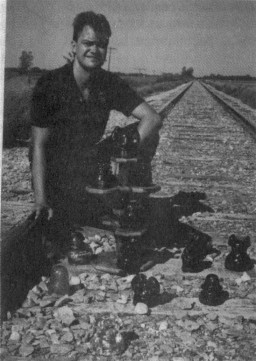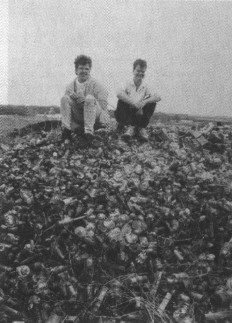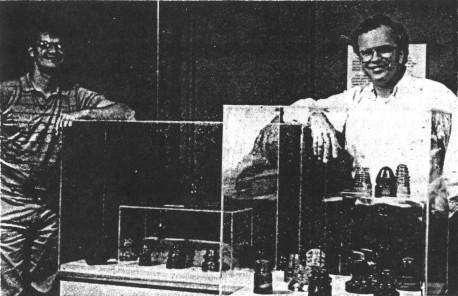"Crown Jewels" Historical Hobby Is Future Investment
Reprinted from "Crown Jewels of the Wire", February 1991, page 23
Power line insulators are called the "Crown Jewels of the wire"
because they come in jewel colors -- sapphire blue, emerald green, golden amber,
royal purple, opalescent, ice aqua or jade green milk.
These glass insulators
used to sparkle like jewels in the sun from their high perches on telegraph,
telephone or electric power lines. The insulators were placed on the tops of
poles to prevent leakage of the electric current.
"When I was a kid, I used
to walk the rails and look for insulators under power line posts along the
rights-of- ways of railroad tracks here in Brookings," says Ross Berndt, an
insulator collector.
Berndt says the first insulators were made more than 100
years ago and are classified as antiques.
"Glass was used because it did
not absorb water, didn't rust, rot, corrode or lose its shape. And because it's
transparent it could easily be inspected for cracks or breakage," Berndt
says.
Berndt, 28, has more than 200 insulators, most of them purchased from other collectors. Many of the ones he collected as a boy are stored in boxes
in his basement. Some he has given to friends.

Ross
Berndt displays examples from his insulator collection
on the railroad tracks
west of Brookings, South Dakota.
He used to walk the rails to look for
insulators under the
power line poles on the railroad right-of-way.
(Photo by
Keven Schmidt, Instructional Media Center, SDSU)
Berndt says the insulators he
collected as a boy in Brookings are limited to two colors and clear. "I had
lost interest in collecting insulators because I thought everything came in
blue, green or clear. And I had collected enough of those. I became interested
in collecting insulators again in February 1990, when I saw a display of
insulators belonging to Buck Nielsen in the Brookings Public Library.

A friend and Ross Berndt sit atop a dumpsite in South
Dakota. Most were
broken and common, but it
provided a great deal of fun digging through them.
"Nielsen had all the colors, amber, purple, carnival glass. I thought, where did he get that stuff? I was
curious so I called him on the phone and he said I could come over to view the
rest of his collection. I couldn't believe what I saw. He had insulators of
various colors, shapes and sizes displayed on glass shelves with back lighting.
It was impressive, " Berndt says.
Berndt credits Nielsen for helping to
reintroduce him to collecting insulators as a "serious" hobby.
Berndt
displays his insulator collection on shelves positioned along the window wall in
his bedroom.
The most expensive insulator in his collection is the Columbia
which collectors call the "Batman." Berndt paid $125 for it, and says
over time it will be worth much more.
"The best deal I got on insulators
was 13 pieces for about $2.00 each. They were worth more than $122 and I paid
$26 for all of them," Berndt says.
According to an old price list in one of Berndt's books, insulators sold for 5 cents to 30 cents in lots of 5,000 in 1941
(about 50 years ago), Nielsen says according to his research, insulators sold
for 3 to 8 cents per 100 about 100 years ago.
"They weren't cheap then and
they aren't cheap now. You can pay into the thousands of dollars just for one
insulator in today's market," Berndt says.
According to Berndt, demand
determines price. The value is influenced by age, rarity, beauty of shape, color
and special appeal.
Buck Nielsen, a telephone line repairman for the city of
Brookings, has 506 insulators in his collection.
"Investing in insulators
is better than investing in the stock market. Nobody ever looks ahead. Now that
radio, microwaves and underground cable are replacing wire, insulators are going
to be worth more as people collect them for a bit of history," Nielsen
says.
Nielsen says a lineman for the Chicago Northwestern Railroad got him
interested in collecting insulators.
"I bought some insulators from him to start my collection. Now I buy
anything I don't have, I got to some of the larger shows to find new ones."
Berndt was able to find insulators while walking the rails, because of a special
deal Western Union Telegraph made with the railroad companies more than 100
years ago. In this special arrangement, railroad companies agreed to lay
telegraph lines along the railroad right-of-ways; provide office space in depots
for telegraphers (who were employed by the railroad and the telegraph company);
and provide free transportation for people who repaired the telegraph lines.
In
exchange, Western Union provided free service to messages transported by the
railroads and gave a priority to messages concerning train movement. This helped
coordinate train schedules and increased safety. Trains were moved quickly
because the telegraph enabled them to use a common time standard transmitted to
every station at the same time.
And if there was a pile of snow on the tracks up
ahead, a message could be sent out and the snow could be removed before the
train arrived. Telegraph companies need moisture-resistant insulators because
leaky insulators could destroy a business. That's because moisture created
static on the lines and the messages sent would be so garbled that they were not
understood. Eventually the wires would rust out.
Every shape and design of
insulator was tried and field-tested in an effort to find the best insulator.
More than 800 types were made by several different glass companies (more than
enough to keep hobbyists busy trying to complete their collections).

Ross Berndt, left, and John Awald, right, director of the Agricultural
Heritage
Museum, stand by insulators on display at the museum. (Photo by Kristin
K. Anderson)
The hobby
of collecting insulators has a unique historical tie-in with rural
electrification and the communications industry. Berndt and Nielsen worked with
John Awald, curator of the South Dakota Agricultural Heritage Museum on campus, to put together a display of
insulators to recognize the role of the role the insulator played in assuring
the success of telegraph, telephone and rural electricity.
"The 24
insulators in Berndt's and Nielsen's collections shows American inventiveness
and creative genius at its best. Each insulator has a different shape or size
and each one was designed to solve one main problem -- how to keep the current
from migrating from the wire to the ground," Awald says.
Historically,
rural electricity helped the American farmer and rancher increase productivity
to feed the nation and the world at a cost that allowed Americans to spend less
of their income for food than any other nation in the world. Because of rural
electricity, industries located in rural areas and provided jobs.
According to
Awald, life was pretty grim before electricity came to rural America. The farmer
had to haul water from a pump or well to water his cows, and he did the milking
and everything else by hand. The farm wife carried endless buckets of water to
do the washing, cleaning, cooking and canning. And she had to cook over a hot
wood stove on the hottest of summer days.
At night all worked ceased. Family
members sat by a dim kerosene lamp or candle so the children could do their
homework and the mother could do her hand sewing. There were no refrigerators or
freezers for preserving food and there was no radio for the news or
entertainment.
"The rural electrification program, with assistance from
government loans, brought electric current at reasonable rates to remote and low
density areas on a non-profit basis. Part of the excitement was stringing the
power lines and topping the poles with insulators.
"The insulator was a
small thing but it did its job by helping to keep the current flowing along the
wires for the telegraph, electric power companies and the telephone companies,
"Awald says.
Awald has been director of the museum for 13 years. He has a
bachelor's degree in anthropology from the University of Arizona and a master's
from the University of Wisconsin.
"Keep your eyes open and search real
hard, you may find a gold mine. You have to go out there and look. It's not
going to come to you," Berndt says.
Berndt says the one place collectors
should not look for insulators is on the tops of power line poles. He says children should be warned of the dangers of
trying to climb the poles to get insulators.
"The wires are hot and a person
could get electrocuted," Berndt says.
Berndt says his collection is a
financial investment for his future and an investment for his present enjoyment.
"The hobby has also given me a chance to meet some wonderful people. We
have a common bond. Every insulator collector that I have met has been a real
friendly person.
"Since March I have visited in the home of 30 insulator
collectors in Omaha, Sioux City, and several places in Minnesota. I drove up to
a woman's home in Orange City, Iowa, and I knew she was an insulator collector
because in front of her house was a sawed-off line pole with insulators still on
it -- holding her mailbox," Berndt says.
How does a new collector get
started in this hobby? According to Berndt and Nielsen, one should subscribe to the
publication Crown Jewels of the Wire, and join the National Insulator
Association.
Berndt, the son of Wayne and Elaine Berndt, moved to Brookings in
1964 when his father accepted a position as an extension specialist at SDSU. The
1980 graduate of Brookings High School has earned four college degrees --
business
education and business administration from Dakota State University in 1985 and
degrees in elementary education and special education from Northern State
University in 1989. He is employed as a staff assistant/writer at the Office of
University Relations at SDSU.
(This article from the October 1990 issue was printed with the permission of
"PREVIEW Plus" which is published monthly by the Office of University
Relations at South Dakota State University, in cooperation with the Brookings
Daily Register. Its author was Lois Y. Hatton, an Information Specialist with
the Office of University Relations.)
| 